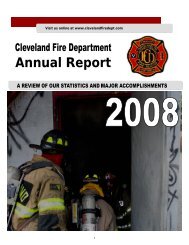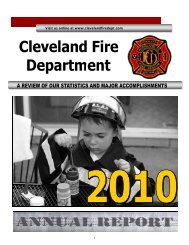SOP Manual - Cleveland Fire Department
SOP Manual - Cleveland Fire Department
SOP Manual - Cleveland Fire Department
- No tags were found...
Create successful ePaper yourself
Turn your PDF publications into a flip-book with our unique Google optimized e-Paper software.
<strong>Cleveland</strong> <strong>Fire</strong> <strong>Department</strong><br />
Operations <strong>Manual</strong><br />
A. Approach<br />
Once the Ladder/Truck is at the fire scene, it shall advance in a slow, deliberate approach to the<br />
fire building. No Company shall try to beat another Company to a position whether it is an Engine<br />
or Ladder/Truck; such foolishness can only lead to poor positioning, accidents, and injuries. The<br />
Company Officer should be concerned only with getting a good position from which the Company<br />
can work efficiently.<br />
The Ladder/Truck must not be committed (that is, stopped, the wheels chocked, the jacks set, etc.)<br />
until it is in the proper position. This can only be determined after the truck has made its approach<br />
to the fire ground and the fire conditions have been observed.<br />
B. Positioning<br />
Rescue<br />
In areas of one-story and two-story buildings, it is not usually essential that the Ladder/Truck be<br />
positioned directly at the front (or rear) of the fire building.<br />
Since the platform will probably not be used in Ladder/Truck operations in such low-rise<br />
structures, the Ladder/Truck can be positioned to one side of the building. This will leave the<br />
priority positions for the Engine Companies, but will not hinder Ladder/Truck operations.<br />
A Ladder/Truck shall avoid a position that blocks Engine Companies from a hydrant or protective<br />
system intake. (Sprinkler or Standpipe Connections)<br />
If the fire building is more than two stories high, the Engine Companies must allow the<br />
Ladder/Truck Companies to get close to the building so aerial units can be positioned effectively<br />
and so the larger ground ladders can be raised quickly. Engines must leave a minimum of 50', if<br />
possible, behind the Ladder/Truck when spotting an Engine. This will insure that ground ladders<br />
can be removed.<br />
The extent, location, and intensity of the fire might not allow for perfect positioning of the<br />
Ladder/Truck. In these cases, the Ladder/Truck shall be positioned as well as possible and<br />
operations initiated without delay. If the building height and the intensity of the fire require such<br />
action, the Ladder/Truck shall be positioned for use of the elevated stream. Or, the best plan of<br />
action might be to position the Ladder/Truck some distance from the building to allow firefighters<br />
to perform their duties without unnecessary hazards.<br />
When the fire building is one of several row buildings of the same height, the Ladder/Truck can be<br />
positioned so the roof of an adjoining building can be laddered. The firefighters can then work<br />
their way from the adjoining roof to the fire building roof for venting and to the rear for other<br />
duties.<br />
Rescue of people in danger is the primary objective of a fire company and the first duty to be performed at<br />
the scene of a fire.<br />
Until such time as the <strong>Fire</strong> <strong>Department</strong> establishes a Rescue Company, the Ladder/Truck Company shall<br />
provide rescue operations. When a Rescue Company is established, the Ladder/Truck Company shall<br />
provide rescue whenever the Rescue Company is not on the scene. When a rescue is in progress, at the<br />
discretion of Command, a member or members from an Engine Company may be temporarily assigned to<br />
the Ladder/Truck Company to facilitate rescue.<br />
Effective: June 1, 1997 Revised: 5/14/2009 Page | 200<br />
Approved by: Chief Chuck Atchley




